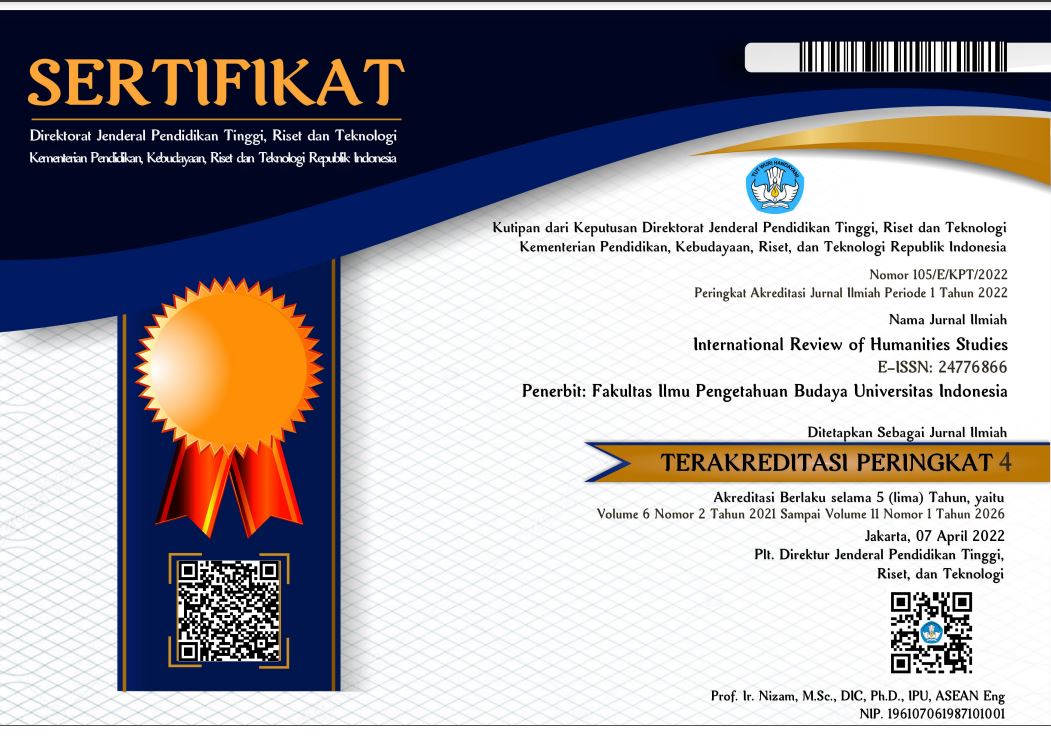International Review of Humanities Studies

Abstract
This study discusses the Hindu-Buddha religions in the ancient Javanese society which developed in 8—15 th Century AD when the centers of the kingdoms in the central part of Java. The case discussed in this paper is concerned with their ritual and ceremony tools used by the worshipped of Hindu-Buddha religions, especially in the regards with the statues of Hindu-Buddha gods, which are still used up to the present time. The statues of Hindu-Buddha gods are actually the realization of wishes to fulfill their worshipper hopes. This study in line with the opinion of Melford E.Spiro (1977), an expert on religion studies, who states that religion tools and rituals can be considered as expressive desires of the religion worshipper. The statues of Gods, temple structure, and reliefs function ot only as decorative matters, but also as expressive desire of silpins (religious artisants) and the community who performs the rituals in regard with their belief. It can be said that these silpin in the ancient Javanese society were doing religious ceremonies and their dedication to their Gods while they were constructing to the statues, reliefs, and temple. It is then these silpins are expressing (1) their dedication to the God by designing certain statues or narrative reliefs, and (2) personal and community expresses in creating religiously aesthetic artifacts.
References
Deezt, James. (1967). Invitation to Archaeology. New York: The Natural History Press.
Dumarcay, Jacues. (1986). The Temples of Java. Singapore: Oxford University Press.
Koentjaraningrat. (1980). Sejarah Teori Antropologi I. Jakarta: Universitas Indonesia Press.
Munandar, Agus Aris. (2003). Aksamala: Bunga Rampai Karya Penelitian. Seri Kajian Arkeologi. Bogor: Akademia.
-------------. (2011). Catuspatha Arkeologi Majapahit. Jakarta: Wedatama Widya Sastra
-------------. (2016). Arkeologi Pawitra. Jakarta: Wedatama Widya Sastra.
Soekmono, R. (1974). Candi, Fungsi dan Pengertiannya. Thesis, Universitas Indonesia, Jakarta.
Spiro, Melford E. (1977). “Religion: Problems of Definition and Explanation, in Michael Banton (Penyunting), Anthropological Approaches to the Study of Religion. London: Tavistock Publications, pp. 85—126.
Suleiman, Satyawati. (1981). Monumen-monumen Indonesia Purba. Jakarta: Pusat Penelitian Arkeologi Nasional.
Susanti, Ninie. (2013). Patirthan Masa Lalu dan Masa Kini. Jakarta: Wedatama Widya Sastra.
Van Peursen, C.A. (1985). Strategi Kebudayaan. (Translated into Indonesian by Dick Hartoko).Yogyakarta: Kanisius & Jakarta: BPK.Gunung Mulia.
Van Romondt, V.R. (1951). Peninggalan-peninggalan Purbakala di Gunung Penanggungan: Hasil Penjelidikan di Gunung Penanggungan selama tahun 1936, 1937, dan tahun 1940 dan Beberapa Peninggalan Purbakala di Gunung Ardjuno Dikundjungi dalam tahun 1939. Djakarta: Dinas Purbakala Republik Indonesia.
Recommended Citation
Munandar, Agus Aris
(2019)
"ARCHAEOLOGICAL ARTIFACTS AS EXPRESSIVE DESIRE OF HINDU-BUDDHA RELIGIONS IN JAVA IN 8th–15th CENTURIES,"
International Review of Humanities Studies: Vol. 4:
No.
2, Article 11.
Available at:
https://scholarhub.ui.ac.id/irhs/vol4/iss2/11
Included in
Archaeological Anthropology Commons, Arts and Humanities Commons, Education Commons, Folklore Commons, Life Sciences Commons, Social and Cultural Anthropology Commons


